Choosing the right mountain bike can be overwhelming, with countless brands, models, and categories vying for your attention. At usabikers.net, we’ve rigorously tested and evaluated a wide range of mountain bikes to bring you a curated list of the top performers. Whether you’re a seasoned trail veteran or a weekend warrior, our expert reviews will guide you in finding the ideal bike to conquer any terrain.
Best Overall Trail Bike
Specialized Stumpjumper 15 Comp
 specialized stumpjumper 15 comp
specialized stumpjumper 15 comp
Specialized Stumpjumper 15 Comp trail mountain bike, offering adjustable geometry and innovative GENIE shock technology.
OVERALL SCORE: 86
- Fun Factor: 9.0
- Downhill Performance: 9.0
- Climbing Performance: 8.0
- Ease of Maintenance: 8.0
Measured Weight: 32 lbs 9 oz (S4) | Rear Travel: 145mm
REASONS TO BUY:
- Adjustable headtube and BB height for customized geometry
- Innovative New SWAT box for on-bike storage
- GENIE Shock technology for enhanced traction
REASONS TO AVOID:
- Incremental upgrade from the Stumpjumper EVO model
- Rear brake rotor size may be excessive for some riders
- Considered hefty for a carbon trail bike
The latest iteration of the Specialized Stumpjumper, the 15 Comp, presents an evolution rather than a revolution. While it maintains the spectacular performance of its predecessor, the Stumpjumper EVO, the changes are more refined than radical. The FACT 11m carbon frame, boasting 145mm of 4-bar travel, adjustable geometry via the headset and chainstays, an updated SWAT box for integrated storage, and clean routing that omits mechanical derailleur compatibility, speaks to Specialized’s commitment to iterative improvement. While some might argue for more significant changes, the Stumpjumper 15 remains undeniably one of the best trail bikes we’ve had the pleasure of testing.
The headline feature of the Stumpjumper 15 is the GENIE shock, a novel air shock design engineered to deliver a more linear initial stroke and improved traction. Specialized provides extensive data supporting the GENIE’s advantages, and while it performs admirably, it’s worth noting that it doesn’t quite replicate the feel of a coil shock. Interestingly, Specialized offers a wide range of Stumpjumper models, including nine variations, with three featuring coil shocks and three utilizing alloy frames. The Comp model we tested sits as the entry-level carbon option, equipped with SRAM’s advanced S1000 Transmission drivetrain. This drivetrain is undeniably impressive in its performance but contributes to the bike’s considerable overall weight.
On the trail, the Stumpjumper 15 exhibits responsiveness and agility, particularly when set in its steeper geometry configurations. It accelerates quickly and inspires confidence across diverse terrains. In its slackest geometry setting, the bike boasts a 63.5-degree headtube angle and a bottom bracket height as low as 330mm, empowering it to tackle steep and challenging trails with assurance. From bike park laps to relaxed cross-country trails, the Stumpjumper feels remarkably versatile. The updated, symmetrical front triangle enhances torsional rigidity, lending the bike exceptional composure at high speeds and during aggressive riding. The GENIE shock genuinely enhances traction, and when paired with a relatively steep seat tube angle (ranging from 76.7 to 75.8 degrees), the bike climbs with notable efficiency and enthusiasm.
Our primary reservation regarding the Stumpjumper 15 is its native 203mm rear brake mount. Combined with the powerful Maven Bronze brakes, this setup can deliver more rear braking force than typically desired on a trail bike.
Read more: Specialized Stumpjumper 15 Comp review
Ultimately, the Specialized Stumpjumper 15 Comp is a true all-rounder, excelling in the performance characteristics that define a top-tier trail bike and solidifying its position as our top pick in the category.
Credit: GearLab Staff
Best Aggressive Trail Bike
Ibis Ripmo V2 XT
OVERALL SCORE: 89
- Fun Factor: 9.0
- Downhill Performance: 9.0
- Climbing Performance: 9.0
- Ease of Maintenance: 7.0
Wheel Size: 29-inch | Rear Travel: 147mm
REASONS TO BUY:
- Well-balanced all-around performance capabilities
- Confidently descends challenging trails
- Efficient and capable climber
REASONS TO AVOID:
- Not the lightest bike in its category
- Represents a somewhat expensive investment
The Ibis Ripmo V2 XT has undeniably set a new benchmark in the aggressive trail bike category, outperforming its competition with an unparalleled blend of climbing efficiency and descending prowess. This bike isn’t just the best aggressive trail bike we’ve tested; it’s a potential legend in the making, a bike that propels the sport forward. The updated geometry features a slightly slacker 64.9-degree headtube angle and a longer 1238mm wheelbase, while the suspension kinematics have been refined for increased progressivity towards the end of its travel. Already renowned for its confident descending capabilities, the Ripmo V2 now feels even more composed and planted in demanding terrain. The combination of high-speed stability and big-hit performance instills a sense of fearlessness. Few bikes can rival the Ripmo; while the Santa Cruz Hightower is a superb contender, it doesn’t quite match the Ripmo’s high-speed composure and audacity. Although the Hightower excels in deep stroke compliance, the Ripmo is equally impressive in this aspect. The Ripmo’s 435mm chainstays contribute to a tight rear end, lending it a sporty and responsive character that facilitates quick directional changes. In essence, the Ripmo’s handling is lively, energetic, and precise. Furthermore, the Ripmo climbs exceptionally well, thanks to its efficient DW-Link suspension platform, steep seat tube angle, and meticulously engineered kinematics. The term “quiver killer” is genuinely apt for the Ripmo, as it’s a single bike that excels across a broad spectrum of riding disciplines.
The Ripmo V2 embodies a well-balanced, aggressive trail bike with a remarkable synthesis of uphill and downhill performance. It’s ideally suited for riders who relish climbing but refuse to compromise on descending capability. This bike is a true engineering marvel, and our enthusiastic praise is well-deserved. Riders seeking the Ripmo experience at a more accessible price point should consider the aluminum-framed Ibis Ripmo AF NX.
Read more: Ibis Ripmo V2 XT review
 mountain bike – the ripmo v2 is super capable of handling technical climbs.
mountain bike – the ripmo v2 is super capable of handling technical climbs.
The Ibis Ripmo V2 excels at technical climbing, offering superb traction and efficient power transfer.
Credit: Laura Casner
Best Mid-Travel Trail Bike
Revel Rascal XO Transmission
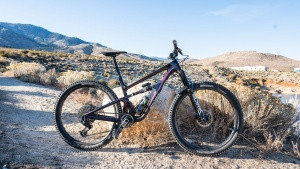 revel rascal xo transmission
revel rascal xo transmission
Revel Rascal XO Transmission mid-travel mountain bike showcasing its versatile design and high-performance components.
OVERALL SCORE: 88
- Fun Factor: 10.0
- Downhill Performance: 9.0
- Climbing Performance: 8.0
- Ease of Maintenance: 7.0
Wheel Size: 29-inch | Rear Travel: 130mm
REASONS TO BUY:
- Exceptional go-anywhere versatility across varied terrains
- Sublime CBF suspension system for optimal performance
- Fantastic wheelset enhancing ride quality
REASONS TO AVOID:
- Represents a premium, expensive purchase
- Non-adjustable geometry limits customization
The Revel Rascal XO Transmission undeniably punches above its weight class, presenting itself as a remarkably capable bike that leverages the Canfield Brothers Formula suspension and cutting-edge thermoset carbon technology. The geometry of the Rascal imparts a playful character, while its suspension encourages riders to push the boundaries of what’s achievable on a 130mm travel bike. The bike’s geometry figures are modern enough to ensure versatility, yet not so extreme as to compromise its lively and agile feel. Revel didn’t simply adhere to the longer/slacker trend in this update; they meticulously refined the bike’s geometry to optimize the ride quality of a mid-travel trail bike, featuring a 436mm rear center within its 1222mm wheelbase. This configuration yields phenomenal traction, whether powering up root-strewn climbs or braking through challenging, uneven terrain. Testers frequently drew comparisons to the Trek Top Fuel 9.8 GX AXS, not due to dimensional similarities, but rather the dialed-in geometry and kinematics that both bikes exhibit. Both models deliver an exceptional ride quality that transcends their specifications. Seasoned riders will be particularly impressed by the suspension’s remarkable isolation from rider input. The SRAM XO Transmission build, complemented by Revel RW30 Carbon wheels, leaves little to be desired, incorporating top-tier suspension components from RockShox and a drivetrain built for demanding use.
While the Rascal may lack frame storage and adjustable geometry, features increasingly sought after by riders, its exceptional performance makes these omissions easy to overlook. Although adjustable geometry can enhance a bike’s adaptability, the Rascal hardly lacks versatility. In fact, it seemed to excel particularly on trails that felt “a bit too much” for other bikes with comparable geometry and travel. Conversely, the Rascal never felt excessive, even on mellow cross-country trails. For performance-oriented riders seeking a bike without compromise, the new Rascal is an ideal choice, so much so that Revel guarantees it. Having tested numerous high-end mountain bikes annually, the Rascal stands out as a truly exceptional model that justifies its premium price tag. Hopefully, Revel will introduce a more accessible version of this bike to market without sacrificing its inherent magic.
Read more: Revel Rascal XO Transmission review
The Revel Rascal XO Transmission delivers a spectacular blend of performance and style, making it a mischievously fun trail companion.
Credit: Matt Lighthart
Best Technical Trail Bike
Yeti SB140 LR T2 TURQ
OVERALL SCORE: 86
- Fun Factor: 9.0
- Downhill Performance: 8.0
- Climbing Performance: 9.0
- Ease of Maintenance: 8.0
Wheel Size: 29-inch | Rear Travel: 140mm
REASONS TO BUY:
- Phenomenal traction for confident riding
- Precision handling across various terrains
- Fun and engaging on any trail type
REASONS TO AVOID:
- Represents a costly investment
- Geometry is not adjustable, limiting customization
- Lacks in-frame storage options
The Yeti SB 140 stands out as a top-tier mid-travel trail bike, offering a ride that feels both precise and efficient. This 140mm 29er delivers exceptional ride quality and performance that surpasses what its geometry specifications might suggest. Whether tackling steep ascents, fast-flowing trails, high alpine epics, or jump lines, the SB140 is remarkably capable. With excellent climbing traction and a near-ideal rider position, its longer 440mm chainstays keep the rear wheel firmly planted on technical terrain and challenging climbs. The Yeti is equally impressive when pointed downhill, maintaining superb small bump sensitivity throughout its travel range. The headtube angle, while not extreme, provides the bike with a spry and agile feel. We were particularly impressed by the Yeti’s balanced feel and precise tracking. The SB140 inspires confidence in all but the most extreme terrain, where its speed limit becomes apparent. While undeniably capable of aggressive riding, this bike feels more refined, akin to off-roading in a Range Rover.
If frame storage or adjustable geometry are priorities in your trail bike search, the SB140 may not fully meet your needs. Similarly, more aggressive riders might prefer longer travel, slacker bikes. The Yeti prioritizes agility and athleticism, relying less on excessive travel and mass. Its exceptional traction allows riders to push cornering and braking limits, making it an ideal companion for the majority of singletrack trails across North America. Hop onto a Yeti SB140 and experience how deftly this bike handles trail duties. For riders seeking something with a bit more rowdiness, the Ibis Ripmo V2 XT or Specialized Stumpjumper 15 Comp are worth considering.
Read more: Yeti SB140 LR T2 TURQ review
Accurate and adept aptly describe the ride of the SB140. While not the biggest or most aggressive bike, it feels incredibly capable across a wide range of trail conditions.
Credit: Abriah Wofford
Best Short Travel Trail Bike
Trek Top Fuel 9.8 GX AXS
 trek top fuel 9.8 gx axs
trek top fuel 9.8 gx axs
Trek Top Fuel 9.8 GX AXS short travel trail bike featuring Mino-Link adjustable geometry and downtube storage.
OVERALL SCORE: 83
- Fun Factor: 8.0
- Downhill Performance: 8.0
- Climbing Performance: 9.0
- Ease of Maintenance: 7.0
Measured Weight: 29 lbs 9 oz (large) | Rear Travel: 120mm
REASONS TO BUY:
- Mino-Link system for adjustable geometry and leverage rates
- BITS bag integrated downtube storage solution
- Compatible with 130/140mm suspension configurations for increased travel
- Mullet (MX) wheel compatibility expands versatility
REASONS TO AVOID:
- Wheels are heavier than ideal for optimal performance
- Short saddle design may not suit all riders’ preferences
The latest generation of the Trek Top Fuel 9.8 GX AXS delivers modern geometry and several clever updates. Now categorized as a “down-country” bike—a somewhat ambiguous term, this 120mm OCLV carbon trail bike is surprisingly capable. It excels on climbs, rivaling modern cross-country bikes with its quick, responsive handling and remarkably supportive pedaling platform. Handling is nimble and quick, aided by a 76.3-degree seat tube angle that promotes efficient pedaling, even on steep gradients.
Descending capability is enhanced by the ABP suspension, which effectively isolates braking forces from suspension action. A 65.9-degree headtube angle slows the steering just enough for confident descending without compromising its exceptional climbing performance. A 1227mm wheelbase contributes to stability and a higher speed threshold than one might expect from a short-travel bike. During testing, we felt the “short travel” designation undersold the bike’s capabilities; the Top Fuel exhibits flow, finesse, and genuine trail pedigree.
A smart 4-way Mino-Link allows for geometry and leverage rate adjustments, and Trek has also made the bike compatible with longer shocks and forks, enabling riders to run 130/140mm of travel. Larger wheels are fitted to M, ML, L, and XL models, while the S size gets 27.5″ wheels; the larger sizes are also mullet (MX) compatible. Frame storage via the Bontrager BITS system keeps essential tools and tubes organized and quiet.
The Top Fuel is a well-balanced trail bike with significant adjustability, challenging the notion that trail bikes must have excessive travel. Trek’s confidence in the bike is underscored by a 30-day Unconditional Guarantee.
Read more: Trek Top Fuel 9.8 GX AXS review
Short travel doesn’t equate to short on fun; the new Top Fuel is incredibly versatile and a joy to ride across diverse trail conditions.
Credit: Matt Lighthart
Best Trail Bike Under $3000
Ibis Ripmo AF NX Eagle
OVERALL SCORE: 80
- Fun Factor: 8.0
- Downhill Performance: 9.0
- Climbing Performance: 7.0
- Ease of Maintenance: 7.0
Wheel Size: 29-inch | Rear Travel: 147mm
REASONS TO BUY:
- Progressive and aggressive geometry for confident trail riding
- Confident descender on challenging terrain
- Adept climber for its category and price point
REASONS TO AVOID:
- Heavy aluminum frame construction (AF – Aluminum Frame)
- Sits at the upper end of the budget price range
The Ibis Ripmo AF emerges as a true workhorse trail bike, capable of both finesse on technical trails and surprisingly efficient climbing. Its 147mm of DW-Link travel, coupled with updated kinematics, provides a bottomless feel without the sluggishness often associated with such travel figures. The Ripmo AF ride is lively, energetic, playful, and inherently fun; the bike encourages riders to push their limits. A 160mm fork paired with a 64.9-degree headtube angle makes the Ripmo excel at rapid descents. The steeper the terrain, the better this metal ripper performs. Yet, with its 76-degree seat tube angle, this bike is also a capable climber, as proficient as a 34lb trail bike can be. The Ripmo AF feels like a testament to how dialed geometry can elevate rider performance. Ibis has done an exceptional job with the bike’s component specification: robust suspension, wide rims, high-traction tires, and a reliable, no-fuss drivetrain. 4-piston brakes and a long-travel dropper post further enhance the bike’s capabilities and inspire rider confidence. The carbon version of the Ripmo is our Editors’ Choice, utilizing the same platform but with lighter components and a reduced weight.
So, why might one hesitate to purchase this bike? At 34 pounds, it can feel substantial when maneuvering through the woods. The bike’s weight is further compounded by suspension that lacks advanced valving to maximize pedaling efficiency. It’s also a relatively long-travel bike, which, while enhancing its capabilities, might be more bike than some riders require. However, the Ripmo AF feels bold, underpriced for its performance, and incredibly fun to ride.
Read more: Ibis Ripmo AF review
Heavy metal indeed! The Ripmo AF absolutely rips on descents, although it’s not the lightest bike for all-around trail riding. You’ll be hard-pressed to find a more capable bike for under $3000.
Credit: Matt Lighthart
Best Full-Suspension Bike Under $2000
Canyon Neuron 5
 mountain bike
mountain bike
Canyon Neuron 5 full-suspension mountain bike, an excellent value option for trail riding with focus on climbing.
Wheel Size: 29″ | Weight: 33 lbs 10 oz (size large, set up tubeless)
REASONS TO BUY:
- Excellent climber, efficiently tackling uphill sections
- Outstanding value for a full-suspension mountain bike
- Geometry maintains fun and responsiveness at slower speeds
REASONS TO AVOID:
- Optimized for moderate terrain, less suited for aggressive trails
- Less aggressive tire tread limits grip in technical conditions
- Considered heavy for its travel category
The Canyon Neuron 5 is a trail bike that leans towards its cross-country (XC) origins. Its 130mm of travel, paired with slightly steeper geometry compared to most trail bikes, delivers a snappy and responsive ride quality. This bike is most enjoyable on trails that aren’t overly challenging. The Neuron resists becoming excessively long, slack, or extreme, making it ideal for riders who don’t require or desire a big-travel trail slayer and prefer less demanding trail days. Handling is crisp and responsive, and the bike climbs with an athleticism that characterizes its overall ride. Ascending trails and fire roads on the Neuron is a genuine pleasure; the bike rewards rider input with efficient progress. If your riding style tends to avoid overly technical lines or trailside jumps, the Neuron is well-suited to your needs.
While the Neuron excels on mellower terrain, pushing it into rougher, more challenging trails reveals its limitations. The responsive geometry that’s an asset on smoother trails can become overwhelmed at higher speeds. The 2.4-inch Schwalbe tires, with their low-profile, efficient knobs, are fast-rolling but reach their grip limit when trails become loose or technical. Riding steep sections is certainly possible, but it demands more skill and confidence from the rider. While the bike’s weight doesn’t significantly hinder general riding, it feels heavy in technical situations.
Read more: Canyon Neuron 5 review
The Canyon Neuron 5 finds its flow on moderate trails, delivering a fun and exciting ride experience without needing extreme terrain.
Credit: Pat Donahue
Best Budget Mountain Bike
Norco Fluid FS 4
OVERALL SCORE: 81
- Fun Factor: 8.0
- Downhill: 9.0
- Climbing: 7.0
- Build: 8.0
Wheels: 29-inch | Rear Travel: 130mm
REASONS TO BUY:
- Highly competent performance on difficult terrain
- Confident and stable at high speeds and on steep trails
- Features a long-travel dropper post for enhanced descending
REASONS TO AVOID:
- Heavy overall weight impacting climbing efficiency
- Rear shock lacks a climb switch for improved uphill performance
The Norco Fluid FS 4 is our top pick for the best budget mid-travel mountain bike. This bike is so capable that it quickly dispels any notion of being a “budget bike.” Whether charging down high-speed flow trails or navigating technical, chunky terrain, the Fluid remains composed and delivers an exceptionally fun riding experience. This brilliant on-trail performance is complemented by a stellar build kit that includes a wide-range cassette and a long-travel dropper post, making it an easy choice for the Best Budget Mountain Bike award.
Our criticisms of the Fluid are relatively minor. Our extra-large test bike weighed over 36 pounds, which is noticeable in all aspects of its performance. It’s worth noting that we generally test large frames, so a direct weight comparison isn’t entirely fair. We found climbing performance to be adequate, but a climb switch on the rear shock would be beneficial for fire roads or smooth double tracks. Budget-conscious shoppers should also consider the Polygon Siskiu T8, which offers good descending and climbing performance, especially given its price point.
Read more: Norco Fluid FS 4 review
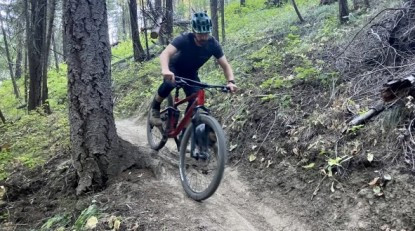 mountain bike – the fluid 4 fs was an incredibly competent descender.
mountain bike – the fluid 4 fs was an incredibly competent descender.
The Norco Fluid 4 FS demonstrates incredible descending competence, offering confident handling on challenging trails.
Credit: Pat Donahue
Best Electric Mountain Bike
Specialized Turbo Levo Comp Alloy
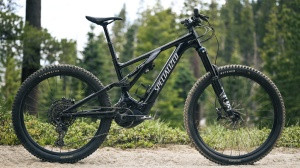 specialized turbo levo comp alloy
specialized turbo levo comp alloy
Specialized Turbo Levo Comp Alloy electric mountain bike, featuring adjustable geometry and a powerful motor system.
OVERALL SCORE: 87
- Downhill Performance: 9.0
- Climbing Performance: 8.0
- Measured Effective Range: 9.0
- Power Output: 9.0
- E-Bike Controls: 7.0
Wheel Size: MX (29″ front, 27.5″ rear) | Rear Travel: 150mm
REASONS TO BUY:
- Powerful and responsive motor system
- Versatile and highly adjustable geometry
- 700Wh battery offers excellent range for extended rides
REASONS TO AVOID:
- No longer leads in battery capacity compared to competitors
- Lower-end models lack a digital display for key metrics
- Stock tires could benefit from tougher casing for aggressive riding
The Levo’s last major update was in 2022, but it remains a dominant force in the e-MTB category. Like the unpowered Stumpjumper, Specialized equipped the Levo with highly adjustable geometry, allowing riders to significantly customize its character to suit their riding style, terrain, and personal preferences. With six distinct geometry settings, the Levo can be configured as a nimble trail bike, an aggressive gravity-oriented machine, or anything in between. This unprecedented level of adjustability truly elevates the bike’s versatility, setting it apart in its class. It features 150mm of FSR rear wheel travel, a 160mm fork, and mixed wheel sizes (29″ front, 27.5″ rear) for a confident front end and playful rear end. Specialized’s Turbo Full Power 2.2 motor is remarkably potent, delivering 90Nm of torque and up to 565 peak watts of output, with three customizable levels of pedal assist. A 700Wh battery is neatly integrated into the downtube, providing substantial range, and the entire system is refined and well-integrated, with balanced weight distribution for a natural ride feel.
The Comp Alloy model is one of the most affordable versions of the Turbo Levo and comes with a functional component spec. However, a couple of areas could be improved. The SRAM Code R brakes are not our preferred choice, and the GRID TRAIL casing tires aren’t as robust as we’d prefer for a bike of this weight and hard-charging nature. While the 700Wh battery is solid, with competitors increasing battery sizes, compatibility with a range extender would be a welcome addition. Regardless, the Turbo Levo remains one of the best and most well-rounded electric mountain bikes available. Its adjustable geometry significantly enhances its versatility. For riders prioritizing maximum range, the 900Wh battery of the Canyon Spectral:ON CF 8 might be a more suitable option.
Read more: Specialized Turbo Levo Comp Alloy review
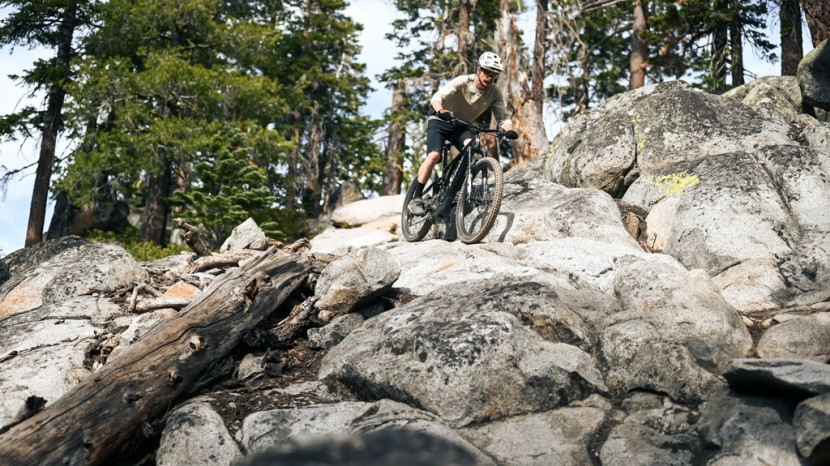 mountain bike – the turbo levo has been refined over the years, and its new…
mountain bike – the turbo levo has been refined over the years, and its new…
The Specialized Turbo Levo has seen years of refinement, with adjustable geometry enhancing its trail versatility.
Credit: Abriah Wofford
Best Electric Mountain Bike for Range
Canyon Spectral:ON CF 8
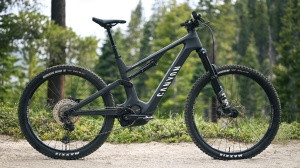 canyon spectral:on cf 8
canyon spectral:on cf 8
Canyon Spectral:ON CF 8 electric mountain bike, designed for extended range with a large 900Wh battery.
OVERALL SCORE: 85
- Downhill Performance: 8.0
- Climbing Performance: 8.0
- Measured Effective Range: 10.0
- Power Output: 8.0
- E-Bike Controls: 8.0
Wheel Size: MX (29″ front, 27.5″ rear) | Rear Travel: 155mm
REASONS TO BUY:
- Comparatively reasonable price point for its features
- Excellent component build for the price
- Massive 900 Wh battery for exceptional range
- Well-rounded trail riding performance capabilities
REASONS TO AVOID:
- Motor/battery bulge reduces ground clearance in technical terrain
- Non-e-bike specific fork component
- Rear tire could benefit from a beefier casing for durability
Canyon recently updated their Spectral:ON models, and the Canyon Spectral:ON CF 8 stands out as a versatile trail e-MTB that also offers exceptional value in the market. This carbon-framed bike features mixed wheels (29-inch front and 27.5-inch rear), 150/155mm of front/rear travel, and modern geometry well-suited for its trail-oriented purpose. Despite its 50+ pound weight, it handles predictably across varying speeds and terrains, offering a great balance of agility, stability, and composure in diverse situations. The popular Shimano EP8 motor delivers up to 85Nm of torque with three customizable support modes to fine-tune assistance. Crucially, it’s equipped with a massive 900 Wh battery, providing the longest range of any electric mountain bike we’ve tested. Canyon’s direct-to-consumer sales model allows for an excellent component build at this price (though still significantly more expensive than electric bikes designed for commuting). While still a significant investment, the Spectral:ON CF 8 offers fantastic value. However, if budget is less of a constraint, the Turbo Levo Comp Alloy is also worth considering before making a final decision, given its powerful motor and adjustable geometry.
Read more: Canyon Spectral:ON CF 8 review
 mountain bike – the spectral:on cf 8 offers a well-rounded on-trail performance, a…
mountain bike – the spectral:on cf 8 offers a well-rounded on-trail performance, a…
The Canyon Spectral:ON CF 8 provides well-rounded trail performance, quality components, and a long-lasting 900 Wh battery at a reasonable price.
Credit: Abriah Wofford
Best Fat Bike
Fezzari Kings Peak Comp
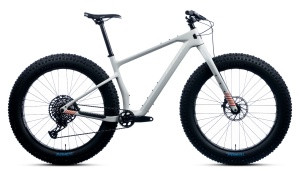 fezzari kings peak comp
fezzari kings peak comp
Fezzari Kings Peak Comp fat bike, designed with modern geometry and ample frame mounts for adventure riding.
OVERALL SCORE: 81
- Downhill Performance: 8.0
- Uphill Performance: 8.0
- Versatility: 9.0
- Build: 7.0
Tire Size: 27.5×4.5-inch | Fork Travel: N/A
REASONS TO BUY:
- Reasonably priced fat bike option
- Modern geometry for confident handling
- Numerous frame and fork mounts for accessories
REASONS TO AVOID:
- SRAM SX shifter ergonomics are not ideal for all riders
- Slip-on grips are a minor point of concern
Fezzari, while not as widely recognized in the mountain bike market, aims to change perceptions with quality bikes across categories, including the Kings Peak Comp fat bike. With geometry reminiscent of a standard trail bike, the longer and slacker Kings Peak delivers a familiar feel on snow and dirt. Fezzari’s 23-point custom setup ensures a comfortable fit, and the angles are well-suited for typical fat bike riding while still being surprisingly capable beyond typical fat bike conditions. Featuring a sleek carbon frame and weighing just 31 pounds, this bike pedals efficiently across diverse surfaces and maintains an appealing aesthetic. The frame and fork offer a multitude of mounting points for water bottles and accessories, making it easily adaptable for bike packing or extended adventure rides. While the component build isn’t flashy, it’s perfectly functional. Fezzari also offers a higher-spec build and various component upgrades.
Beyond a few minor issues, we were highly impressed with the Kings Peak Comp. While we appreciate SRAM Eagle drivetrains, the SX version is less impressive. It functions adequately, but the shifter ergonomics are problematic, often making it difficult to position comfortably. The slip-on grips are easily remedied with lock-on alternatives. The Clarks M2 brakes provide sufficient stopping power for typical fat bike speeds, but long-term performance and durability are uncertain. Otherwise, this bike is excellent and earns our recommendation. We also recommend the Ibis Ripmo V2 XT for conditions that don’t necessitate fat tires and for riders seeking the best all-around trail bike.
Read more: Fezzari Kings Peak Comp review
 mountain bike – the fezzari kings peak proved to be the best all-around fat bike…
mountain bike – the fezzari kings peak proved to be the best all-around fat bike…
The Fezzari Kings Peak has proven to be the best all-around fat bike in our testing, offering balanced performance and versatility.
Credit: Jeremy Benson
How We Test the Best Mountain Bikes
Our mountain bike testing methodology centers on identifying the top MTB bikes on the market and subjecting them to rigorous, hands-on evaluation. Our team of experienced testers pushes these bikes to their performance limits across a diverse range of terrains. We engage in countless bike park laps, all-day epic rides, massive climbs, and demanding descents. Our team has consistently employed this rigorous testing approach since 2017, evaluating trail bikes, enduro bikes, hardtails, fat bikes, electric mountain bikes, and budget mountain bikes. Over the past seven years, we’ve invested over $200,000 in purchasing mountain bikes for review (typically at retail prices) to ensure objectivity and minimize bias. In instances where we utilize media or demo bikes from manufacturers, we insist on paying demo or rental fees. Maintaining our autonomy and remaining free from external influence is paramount to delivering the most unbiased and reliable mountain bike reviews.
Why Trust GearLab
Our Senior Mountain Bike Review Editor, Joshua Hutchens, leads our expert test team. Joshua is a lifelong mountain biker, coach, former racer, guide, and bike shop owner known for his finesse and style on the trails. He possesses extensive experience riding hundreds of different mountain bikes, enabling him to discern even the most subtle performance nuances between models.
For many years, Joshua has collaborated with a diverse team of professional bike testers. Former GearLab Mountain Bike Editor, Pat Donahue, now a bike shop owner, is a highly skilled rider with a preference for steep and technical descents. He is rigorously critical of gear and possesses a keen eye for the performance characteristics that define a great bike. Kyle Smaine, raised amidst iconic trails, was a talented professional skier with numerous halfpipe medals. In warmer months, he dedicates himself to mountain biking, achieving impressive times both uphill and downhill, and is recognized as a highly talented multi-sport athlete in the Tahoe region.
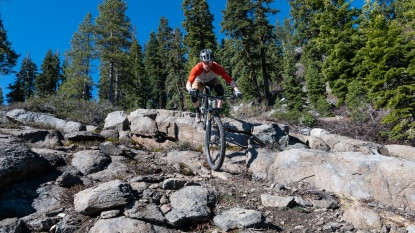 mountain bike – the ripmo v2 is one of our favorite bikes for a reason. there
mountain bike – the ripmo v2 is one of our favorite bikes for a reason. there
The Ibis Ripmo V2 remains a tester favorite due to its exceptional all-around performance capabilities.
Credit: Laura Casner
How to Pick the Best Mountain Bike for You
Purchasing a mountain bike is a significant financial undertaking and can feel daunting. Making such a substantial purchase necessitates thorough research, which can often introduce jargon and unfamiliar terms. Terms like mid-travel, short-travel, and enduro are frequently used but not always clearly understood. OutdoorGearLab is here to demystify these concepts and guide you through the selection process.
We will elucidate the different categories of mountain bikes and their intended purposes. Once you’ve identified a suitable bike category, you’ll need to consider wheel and tire sizes—29-inch, 27.5-inch, and plus-sized options each have distinct strengths and weaknesses. Female riders must decide whether a women’s specific bike is necessary or if a unisex model can be adjusted for a better fit. We’ll walk you through each of these crucial decisions.
Types of Mountain Bikes
Realistically assessing your typical riding terrain is crucial, as the ideal mountain bike type varies significantly depending on where you ride most often. Consider the trails prevalent in your local area and whether you frequently visit bike parks or trail centers.
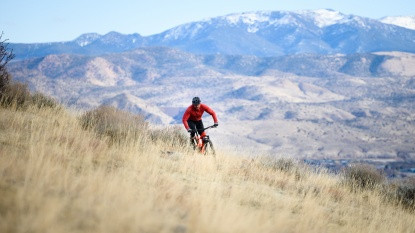 mountain bike – xc bikes are efficient rides for covering long distances and moving…
mountain bike – xc bikes are efficient rides for covering long distances and moving…
Cross-country (XC) mountain bikes are designed for efficient long-distance riding and speed on smoother trails.
Credit: Laura Casner
Cross-Country Bikes
Cross-country (XC) bikes occupy a niche category. If you’re reading this guide, XC bikes may not be the most suitable choice for your needs. Riders specifically seeking XC bikes are typically focused on racing and prioritize weight and efficiency over comfort, fun, and general trail practicality. XC bikes excel on a limited range of trails. Stiff and exceptionally efficient, XC bikes are either hardtails (no rear suspension) or feature approximately 100mm of rear suspension travel. They are characterized by steeper geometry, a low stem position, and a firm, often unforgiving ride.
Riders who primarily ride smooth trails may appreciate the sheer efficiency of XC bikes. However, if you prioritize a playful ride or your local trails are characterized by roots and rocks, XC bikes are likely not the best choice, unless you’re specifically training for XC racing. A short-travel trail bike offers comparable efficiency while providing a far more versatile and enjoyable ride experience.
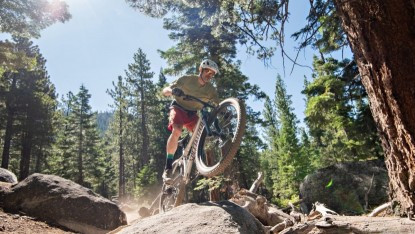 mountain bike – riding a bike is the only way to get to know its performance…
mountain bike – riding a bike is the only way to get to know its performance…
The only way to truly understand a mountain bike’s performance is through riding it, a process that is inherently enjoyable.
Credit: Jenna Ammerman
Trail Hardtails
Hardtail mountain bikes are a compelling option if you prioritize getting out and riding over tackling steep or consistently rough terrain. Simple, low-maintenance, and fast, these no-frills bikes lack rear suspension but incorporate more aggressive trail bike geometry. As a result, they are highly efficient pedallers and capable of handling moderately challenging trails. Less experienced riders can develop valuable bike handling skills on these less forgiving bikes, which reward precise line choices and good riding technique. Trail hardtails are relatively versatile but require caution on descents due to their inherent stiffness. Riders who regularly encounter steeper and rougher terrain should consider a full-suspension bike.
Due to their simpler design, hardtails are generally more affordable than full-suspension bikes, making them an excellent choice for budget-conscious riders. If hardtails seem like the right fit for you, explore our review selection of hardtail mountain bikes.
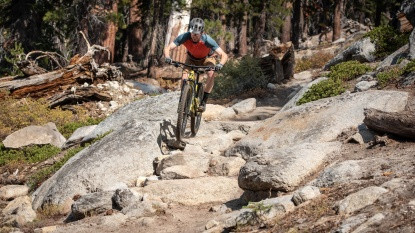 mountain bike – modern short-travel bikes can do it all, only limited by their…
mountain bike – modern short-travel bikes can do it all, only limited by their…
Modern short-travel mountain bikes are remarkably versatile, with their capabilities primarily limited by their suspension travel.
Credit: Jenna Ammerman
Short-Travel Trail Bikes
Short-travel trail bikes are ideal if you value versatility, efficient climbing, and aren’t solely focused on aggressive descending. These bikes typically feature 110-130mm of rear-wheel travel, offering full-suspension confidence and comfort without sacrificing pedaling efficiency. Riders who enjoy covering significant distances will find short-travel bikes comfortable and efficient. This category is well-suited for those riding flatter terrain or mountainous areas who prefer not to push the limits on descents. Riders seeking a more balanced climbing and descending experience might consider mid-travel bikes. If this balance aligns with your riding style, explore the 110-130mm travel options in our constantly updated review of trail mountain bikes. Travel specifications are detailed in the Suspension & Travel row of our Test Results and Rating Table.
Mid-travel mountain bikes strike a balance between climbing efficiency and descending capability, making them highly versatile.
Mid-Travel Trail Bikes
Mid-travel bikes represent an MTB sweet spot, perfect for riders who enjoy challenging descents but still value climbing performance. These bikes are exceptionally versatile, offering strong performance across various riding disciplines. They beautifully balance climbing prowess and descending capabilities, comfortable on the vast majority of trails. Mid-travel bikes are equally at home on occasional bike park visits or 30-mile trail rides. The 130-150mm suspension travel range caters to a broad spectrum of riders. If you primarily ride in flat or smooth regions, these bikes might be overkill. If aggressive descents are the highlight of your rides, consider enduro/long-travel rigs. For those interested in this multifaceted and fun category, our constantly evolving trail mountain bike review features excellent daily driver options in the 130-150mm range. Travel specifications are found near the bottom of the Test Results and Rating Table.
 mountain bike – enduro bikes are for riders who focus more on the descent than…
mountain bike – enduro bikes are for riders who focus more on the descent than…
Enduro mountain bikes are designed for riders who prioritize descending performance over climbing efficiency.
Credit: Jenna Ammerman
Enduro Bikes
Enduro is a frequently overused term, and enduro bikes are designed to excel on technical descents while being capable enough to climb to the top. Long-travel, or enduro, bikes are ideal for riders who prioritize aggressive descending and are willing to carry extra bike weight for enhanced downhill capabilities. With 150 to 170mm of travel, they pedal reasonably well, but efficiency is not their primary strength. These bikes are not optimized for long-distance rides and won’t set climbing records. Enduro bikes are focused on high speeds and challenging downhills. Riders seeking freeride lines or bike park laps will be well-suited to these shred-ready machines.
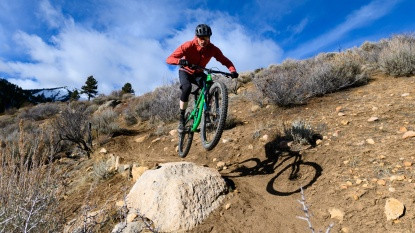 mountain bike – 26-inch wheels are a thing of the past, nearly all bikes have…
mountain bike – 26-inch wheels are a thing of the past, nearly all bikes have…
26-inch mountain bike wheels are largely outdated, with 27.5-inch and 29-inch wheels dominating modern designs.
Credit: Laura Casner
Choosing Bike Components
Once you’ve determined the type of mountain bike best suited to your riding style and terrain, component selection further refines your options.
Wheel Size
Not long ago, all mountain bike wheels were 26 inches in diameter. Now, 27.5-inch and 29-inch wheels are far more prevalent on trails, with 26-inch wheels becoming largely obsolete. Larger wheels offer the advantage of making trail obstacles seem smaller, allowing for more efficient rollover and reduced effort. They are also faster and maintain speed and momentum better through rough terrain. Smaller wheels are argued to be more maneuverable and, therefore, more playful. For a short period, 27.5-inch wheels were considered a sweet spot, balancing the rollover benefits of 29ers with the agility of 26-inch wheels. However, modern frame geometry has significantly improved 29er performance, enabling more precise and playful handling. Mixed-wheel sizes have recently gained popularity. A 29-inch front wheel paired with a 27.5-inch rear, often termed a “mullet” or MX setup, aims to combine the best aspects of both wheel sizes. The larger front wheel improves rollover and stability, while the smaller rear wheel enhances agility and maneuverability. Consider your body size when choosing wheel size, as smaller wheels may feel more comfortable for smaller riders, and larger wheels may suit larger riders on larger frames. Many frames now offer multiple wheel and tire size options, but it’s still crucial to decide on a primary wheel size, as frequent wheelset changes are uncommon.
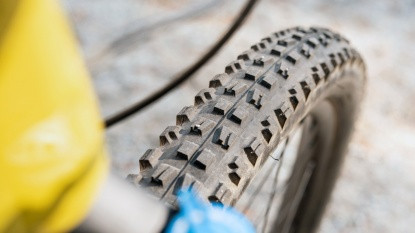 mountain bike – the right tires can make a huge difference in the performance of…
mountain bike – the right tires can make a huge difference in the performance of…
Selecting the right mountain bike tires, such as the Maxxis Minion DHF, can dramatically improve performance.
Credit: Jenna Ammerman
Tire Size and Rim Width
“Normal” mountain bike tire widths have gradually increased. Previously, 2.35-inch tires were considered standard, but now 2.4-2.5-inch tires are common on most trail bikes, with even 2.6-inch options on wider rims. Wider tires offer greater air volume and a larger contact patch, enhancing traction and providing a slightly softer ride, though they may increase rolling resistance uphill. Plus-sized or mid-fat tires range from 2.8-inches to 3-inches. 2.8-inch versions are often preferred for their balance of traction and defined cornering knobs. Three-inch tires offer abundant grip but can sometimes feel vague in corners due to smaller, more uniform knobs. For in-depth tire information, consult our review of mountain bike tires.
Tires are easily swapped and represent one of the most cost-effective ways to upgrade bike performance. Rims are a more significant and expensive component. Rim widths less than 25mm are now considered narrow for aggressive trail or enduro bikes. Aim for rims in the 28mm to 35mm range, with 30mm being an ideal sweet spot. For less aggressive bikes, rim width is less critical, but wider rims generally improve traction across all bike types. Consult manufacturers or dealers regarding recommended tire ranges for specific rims.
 mountain bike – most bikes are offered in a range of build kits and prices.
mountain bike – most bikes are offered in a range of build kits and prices.
Mountain bikes are typically available in various build kits and price points to suit different budgets and performance needs.
Credit: Jenna Ammerman
Choosing a Complete Bike Build
-
Frame: Aluminum vs. Carbon is a primary decision. Aluminum frames are typically more affordable, slightly heavier, and more flexible than carbon. However, they are a great entry point for getting into mountain biking. Carbon fiber frames are more expensive, lighter, stiffer, and excel at vibration damping. Consider carbon if bike investment is a priority and long-term ownership is planned, as carbon fiber generally ages better than aluminum.
-
Fork and Rear Shock: Suspension components vary widely in price. Higher-end forks and shocks offer significantly improved adjustability to rider weight, riding style, and preferences. Heavier riders may find coil-sprung suspension more comfortable and durable than air-only shocks.
 mountain bike – most bikes come with 1x drivetrains that have a huge gear range.
mountain bike – most bikes come with 1x drivetrains that have a huge gear range.
Most modern mountain bikes are equipped with 1x drivetrains, offering a wide gear range with simplified shifting.
Credit: Jenna Ammerman
-
Drivetrain: Consider whether the drivetrain has one (1x) or two (2x) chainrings. 2x drivetrains require a front derailleur and shifters on both handlebars. 1x drivetrains are simpler, easier to shift, allow more space for dropper post controls, and are generally more robust. Most modern mountain bikes utilize 1x drivetrains, typically with 11 or 12 gears.
-
Wheelset: Higher quality wheelsets enhance performance, and rim width is a crucial factor affecting tire effectiveness. Wider rims, along with wider tires, improve traction and ride comfort. Rims are available in aluminum and carbon fiber, with carbon options being significantly more expensive.
Women’s specific mountain bikes often feature components like women’s saddles, grips, bars, and lighter shock tunes.
Credit: Jenna Ammerman
Women’s Bikes
Most mountain bikes are marketed as unisex models. However, women’s specific bikes address fit and performance considerations unique to female riders. Unisex bikes are often designed around average rider metrics, which historically skew male and heavier than the average female rider of comparable height. This can lead to frame sizing issues and overly stiff shock tunes for lighter riders.
Several manufacturers produce women-specific models, with some brands, like Santa Cruz’s Juliana and Giant’s Liv, dedicated solely to women’s bikes. While early women’s bikes often featured unique frame geometry, current models typically utilize unisex frames with women’s specific touchpoints, lighter shock tunes, and distinct color options. These touchpoints include women’s saddles, smaller grips, and sometimes shorter cranks and narrower handlebars.
 mountain bike – making bikes smaller with lighter shock tunes for smaller riders…
mountain bike – making bikes smaller with lighter shock tunes for smaller riders…
Designing smaller bikes with lighter shock tunes for smaller riders is a key aspect of women’s specific mountain bikes.
Credit: Jenna Ammerman
Frame sizing and shock tunes are crucial elements of women’s mountain bikes. Proper fit is paramount, and suspension should respond effectively to smaller impacts while utilizing full travel on larger hits. Many manufacturers now incorporate lighter shock tunes on smaller frame sizes to better accommodate lighter riders.
 mountain bike – minimal assembly required. slap on the wheels and the handlebars…
mountain bike – minimal assembly required. slap on the wheels and the handlebars…
Consumer-direct mountain bikes often require minimal assembly, typically involving wheel and handlebar installation.
Credit: Jenna Ammerman
Consumer Direct vs. Local Bike Shop
Consumer-direct sales are an expanding trend in the mountain bike industry, with more brands bypassing local bike shops and selling directly to consumers. Eliminating the middleman allows companies to offer bikes at more competitive prices. Brands like YT, Commencal, and Canyon are prominent consumer-direct brands in the US market.
However, convenience and cost savings can come with trade-offs. Purchasing from a local bike shop establishes a relationship that can provide benefits like complimentary services, quick repairs, and warranty support. Local bike shops also offer valuable expertise, and trained mechanics can identify and address potential issues proactively.
 mountain bike – more bikes mean more specific talents and more to maintain.
mountain bike – more bikes mean more specific talents and more to maintain.
Owning multiple mountain bikes allows for specialized performance but increases maintenance demands.
Credit: Jenna Ammerman
Multiple Bikes?
Owning a quiver of mountain bikes represents a luxury, offering the ideal solution to maximize enjoyment of the sport. However, it’s also a significant investment. A combination of a short-travel bike and an enduro bike can cover most trail riding scenarios. Realistically, for many riders, a multi-bike quiver isn’t feasible, which is why mid-travel trail bikes are often emphasized. These bikes are highly versatile, suitable for a wide range of terrains, from long rides and shuttle laps to after-work trail sessions. For occasional bike park visits, renting a longer travel bike can be a practical option.
Related: How to Select the Right Mountain Bike
Trainers, Exercise Bikes, and the Off-Season
While some enjoy year-round trail access, off-seasons and time constraints are realities for many. Fortunately, numerous indoor training options exist for maintaining fitness when trail riding isn’t possible. Top-rated exercise bikes have evolved into interactive platforms for solo or group riding, often featuring virtual scenic routes and live group ride options. Bike trainers offer another compelling option, allowing training on your own bike with features comparable to high-end stationary bikes. For those seeking an off-season break from cycling, treadmills, as reviewed in our treadmill guide, can provide an alternative fitness modality.
 mountain bike – there are loads of great mountain bikes to choose from. get a bike…
mountain bike – there are loads of great mountain bikes to choose from. get a bike…
Numerous excellent mountain bikes are available; the key is to choose one and start riding.
Credit: Laura Casner
Conclusion
This guide aims to simplify your mountain bike purchasing decision. Carefully consider your skills, riding goals, and typical terrain. The bikes highlighted are among the best available. OutdoorGearLab remains committed to continuously testing, reviewing, and updating our recommendations of top bikes in the industry to keep this guide current and informative.

 mountain bike
mountain bike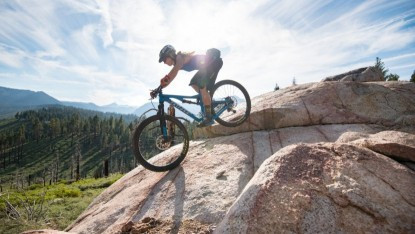 mountain bike – women
mountain bike – women